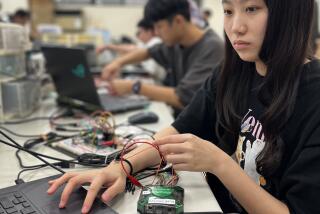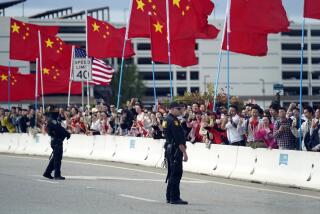As Philippines Show, No Economy Is an Island
They couldn’t have picked a better place than Manila to host the Asia-Pacific economic summit.
The Philippines, a poor country with a rapidly growing economy, reflects many of the promises and problems of Asia’s development. Cheap labor is still the Philippines’ main asset in attracting investment and increasing economic growth, whereas neighboring nations such as Malaysia have moved further up the chain of modern industry to sophisticated multimedia products.
The Philippines is still a market for basic equipment, such as power plants supplied by U.S. companies and financed by countries from around the world.
President Clinton, who is in Manila this weekend, was right to speak last week of the U.S. and Asia pursuing a common destiny into the 21st century. His rhetoric may have seemed misplaced when trade statistics released later showed a rising excess of U.S. imports over exports.
But statistics don’t begin to describe today’ global economy and the interdependent roles of industrial know-how and capital from the United States, Japan, Taiwan and many other nations.
The Philippines’ economy is small, a gross domestic product of roughly $80 billion--less than 2% of the U.S. economy--for a country of 70 million.
The country, of course, is linked to the United States by history. It was annexed in 1898 after the Spanish-American War and given independence in 1946. The Philippines prospered in the early postwar years with an old-style economy of import substitution, high tariffs and revenue from U.S. military bases.
But the Philippines failed to keep pace with such expanding countries as Thailand, Singapore, Malaysia. Its main export became its people, as immigrants to the U.S. or domestic servants to the new-rich Middle East in the 1970s and ‘80s.
Then everything changed. The Cold War ended, U.S. bases closed and the facilities were handed over to Philippine control, and the country in 1992 elected a new president, Gen. Fidel Ramos, a graduate of West Point, who has led it forward. The economy is now growing 7.7% a year and unemployment is at a 17-year low.
Subic Bay, where the Asia-Pacific Economic Cooperation, or APEC, conference is being held, was the biggest U.S. naval base in Asia. Now it is a hub for Federal Express, and its fueling stations are owned by Coastal Corp. of Houston, which uses them to help supply petroleum throughout the region and to refuel ships plying the South China Sea.
The Philippines needed electric power--three years ago it was towing emergency generators on barges to avoid crippling brownouts. So Ramos privatized the government electric company and accelerated power plant construction. Houston-based Enron Inc. built and operates two power plants and is exploring new opportunities. El Segundo-based Unocal, which was running geothermal power plants in the Philippines, agreed to expand them. And Mission Energy, the Irvine-based subsidiary of Edison International, is building a cogeneration plant with CalTex at one of the latter’s refineries.
With increased electric power, the Philippines has been able to grow as an electronics subcontractor, supplying parts of microchips to Texas Instruments, Motorola, Intel and others.
Philippines merchandise trade with the United States has gone from $7 billion four years ago to almost $14 billion this year--roughly $6 billion of imports from the U.S. and $7.6 billion of exports to it.
*
Does that mean Philippine growth is siphoning U.S. prosperity? Not at all. The merchandise figures don’t capture the extent of the business. Those power plants are built and operated with U.S. know-how. “We sell the knowledge of how to operate an electrical system, distribute the power and charge for it,” explains Edward Muller, president of Mission Energy.
The Americans get paid well, and a growing economy increases demand for that knowledge, but know-how doesn’t show up in the trade figures.
Similarly, Philippine work on microchips increases demand for engineering and manufacturing in the U.S. and elsewhere. And work in the Philippines expands markets for other U.S. products and processes, such as the power-supply testing equipment made by NH Research Inc. of Irvine, a $12-million sales company that also earns its keep in the global economy these days.
“The new economy is different from the 19th century, when Britain took cotton from Egypt and India, made a shirt and then sold that shirt back to Egypt and India,” says Alvin Toffler, author of “The Third Wave” and other books, who has just started a consulting firm, Toffler Associates.
Today’s world economy has the potential to provide a rising tide for more boats. For example, both the Japanese and U.S. export-import banks are helping to finance a Mission Energy power plant in Indonesia, notes Richard Drobnick, vice provost of USC and head of its Center for International Business Education and Research. Capital Securities of Taiwan is financing the purchase of Boeing planes for Philippine Airlines.
Philippine consumers’ growing use of detergents has increased demand for surfactant chemicals from Stepan Chemical of Chicago. And Stepan made its business contact in the Philippines through Mindoro International, a consulting company run by Arthur Catapang of Thousand Oaks and his brother, Delfin, a banker in Manila.
*
It’s an exciting, expansive world--but not a perfect one. Cheap labor does undercut U.S. wages. Trident Laboratories of Santa Monica has false teeth made in the Philippines for U.S. dentists, who send Trident plaster casts of patients’ mouths. Dental technicians in the Philippines make $230 a month, compared with $2,000 to $4,000 a month for U.S. technicians. Trident is small, roughly $8 million in sales a year, but growing.
The same dynamic is increasing China’s exports. More of the world’s simple manufacturing work now flows to the land of cheapest labor, even as China buys power plants and tries to move on to the kind of technologically advanced industries that have made Japan, Taiwan, Singapore and Malaysia so prosperous.
The challenge for the 18 APEC nations this weekend is to relieve labor problems arising from such trends and keep the tide and the boats rising.
More to Read
Sign up for Essential California
The most important California stories and recommendations in your inbox every morning.
You may occasionally receive promotional content from the Los Angeles Times.










